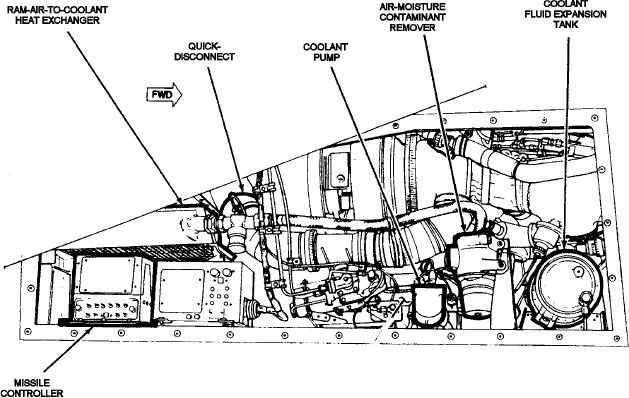
Missile Air-to-Coolant Heat Exchanger
valves modulate the flow of refrigeration system air to
their respective heat exchanger section in response to
The air-to-coolant heat exchanger (fig. 5-29)
electrical signal from the WCS/missile controller. The
consists of two sections: weapons control system
valve has a butterfly, a diaphragm-type pneumatic
(radar) loop, and missile loop. The heat exchanger is
actuator that is mechanically linked to the butterfly, an
similar to an automobile radiator. The coolant flows
electro-magnetic torque motor, and butterfly position
though the core while air flows around the core. When
switches. Electrical signals from the missile controller
the radar portion of the heat exchanger is being used,
govern the torque motor, which allows regulated air
the missile cold and hot air modulating valves are
pressure to be vented. The smaller the amount of air
closed to prevent reverse flow through the missile
pressure vented, the larger the valve opening. If the
section.
electrical power of air pressure is interrupted, the valve
closes.
Missile Coolant Pump
Missile Hot Air Modulating Valve
The coolant pump (fig. 5-30) is a single-stage,
centrifugal pump driven by a low-slip, two-pole
The missile hot air modulating valve (fig. 5-29) is
induction motor. When the pump is operating, it
mounted on the air-to-coolant heat exchanger. The
circulates 18 gallons of coolant per minute through the
valve modulates the flow of hot air from the 400F
system. The pump is lubricated and cooled by a small
bleed manifold temperature control system in response
portion of the coolant, which is circulated through the
to electrical signals from the controller. The hot air
motor. A pressure switch in the pump outlet opens
heats the coolant during system warm-up. The
when the pump output pressure drops to 60 5 psi. The
operation of the valve is the same as the missile cold
pressure switch causes the MSL COND (missile
air-modulating valve.
Figure 5-30.--Missile cooling system component locator.
5-26

